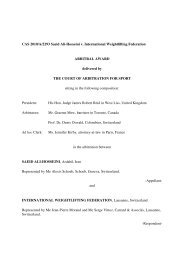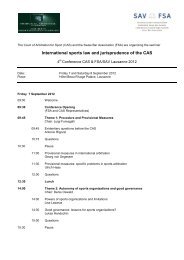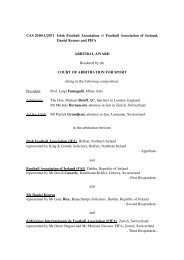(CAS) Bulletin - Tribunal Arbitral du Sport / TAS
(CAS) Bulletin - Tribunal Arbitral du Sport / TAS
(CAS) Bulletin - Tribunal Arbitral du Sport / TAS
Create successful ePaper yourself
Turn your PDF publications into a flip-book with our unique Google optimized e-Paper software.
The Decision seems to be based on the erroneous<br />
assumption that the UCI and WADA are required<br />
to eliminate the theoretical possibility of a case of<br />
clenbuterol-contamination meat in Europe, Spain<br />
or the Basque Country, whereas in reality it is the<br />
Athlete who has the burden of proving that it is more<br />
likely than not that the meat he ate was contaminated<br />
with clenbuterol.<br />
In his closing submissions, WADA’s Counsel alleged<br />
that the fact that WADA is the Appellant and it put<br />
forward and tried to establish alternative theories and<br />
possibilities to the theory of the Respondent, does<br />
not, in any way, effect the principle of who bears the<br />
burden of proof in this case. The question remains if<br />
the burden of proof was met by the Athlete.<br />
According to WADA an adequate subscription of the<br />
balance of probability is given in <strong>CAS</strong> 2008/A/1515 p<br />
23. n°116, according to which “ the balance of probability<br />
standard entails that the athlete has the burden of persuading<br />
the Panel that the occurrence of the circumstances on which the<br />
athlete relies is more probable than their non-occurrence or<br />
more probable than other possible explanations of the positive<br />
testing (see e.g. <strong>CAS</strong> 2006/A/1067, para. 6.8; <strong>CAS</strong><br />
2007/A/1370 & 1376, para. 127)”. The Athlete’s<br />
theory must be established taking into account other<br />
alleged possibilities, but the Panel must be careful not<br />
to shift the burden to the Appellants.<br />
The Athlete must prove more than only a mere<br />
possibility of the occurrence of his theory; he has<br />
to prove how the prohibited substance entered his<br />
system. The Athlete has to establish facts that could<br />
convince the Panel, on a balance of probabilities,<br />
that indeed, in this case: (a) he ate contaminated<br />
meat; and (b) the contaminated meat was indeed<br />
the source of the prohibited substance found in his<br />
body. Here, the missing link in the Athlete’s theory,<br />
according to WADA, is proof that the meat he ate<br />
was contaminated.<br />
3.3. Mr Contador<br />
In his answer of 8 July 2011, Mr Contador’s primary<br />
submission is that he has shown enough evidence that<br />
it was more likely than not that clenbuterol originated<br />
from contaminated meat that he ate. Rather than<br />
conceding the likelihood that contaminated meat<br />
was the cause of his positive test, the Appellants have<br />
proposed various alternatives <strong>du</strong>ring various stages of<br />
the proceedings against him, no matter how unlikely<br />
those alternatives may have been. The Appellants<br />
focus their appeal predominantly on their blood<br />
transfusion theory, while their supplements theory is<br />
merely a fall-back position. This approach appears to<br />
be aimed at countering the Athlete’s contention that<br />
clenbuterol came from contaminated meat.<br />
It is notable that the Appellants have not actually<br />
ruled out contaminated meat as a possibility (because<br />
they cannot do so) but that they have merely asserted<br />
that the blood transfusion theory and the supplement<br />
theory are more likely to have been the source of the<br />
prohibited substance. This leaves the Panel faced<br />
with a choice of three possibilities as to how the<br />
clenbuterol entered the Athlete’s system.<br />
The Athlete alleges that even though Swiss law<br />
governs this arbitration, the “ balance of probability ”<br />
standard applicable to this dispute is a common law<br />
concept. Under Swiss law, the standard of proof is<br />
governed by the rules of law applicable to the merits<br />
of the dispute, here Swiss law and the UCI ADR.<br />
Under Swiss substantive law, the standard of proof<br />
is either the default standard generally referred to<br />
as the “judge’s persuasion” (“conviction <strong>du</strong> juge”) or any<br />
lower standard of proof if so provided for by the<br />
relevant substantive rule itself or by the courts. In any<br />
event, the actual standard of proof to be applied to a<br />
specifi c fact must be determined taking into account<br />
the meaning and the spirit of the law. In particular,<br />
a re<strong>du</strong>ced standard of proof must apply when<br />
proce<strong>du</strong>ral fairness (prozessuale Billigkeit) so requires,<br />
for example because the relevant facts are particularly<br />
diffi cult to establish.<br />
The following re<strong>du</strong>ced standards of proof (preuve<br />
facilitée) are generally applied under Swiss law:<br />
a) high likelihood/plausibility (haute vraisemblance;<br />
hohe Wahrscheinlichkeit), which “is fulfi<br />
lled when according to the judge’s assessment there is no<br />
serious room left for any version of facts diverging from the<br />
alleged version”.<br />
b) Simple likelihood/plausibility (vraisemblance; einfache<br />
Wahrscheinlichkeit, Glaubhaftmachung), which<br />
is satisfi ed when the existence of a fact is supported<br />
by important/signifi cant elements, even<br />
if the judge cannot rule out that – based on less<br />
important/signifi cant elements – the alleged fact<br />
did actually not occur.<br />
Several provisions of Swiss substantive law explicitly<br />
call for the application of such a re<strong>du</strong>ced standard of<br />
proof. In the present case, the relevant substantive<br />
provision is Article 22 UCI ADR, which sets<br />
forth a re<strong>du</strong>ced standard of proof of “ balance of<br />
probability ”. This re<strong>du</strong>ced standard of proof is based<br />
on the WADC and is deliberately different from that<br />
generally used under Swiss law. Indeed, the original<br />
French translation of the WADC refers neither to<br />
“vraisemblance” nor to “haute vraisemblance” and rather<br />
Jurisprudence majeure / Leading cases<br />
-<br />
112





